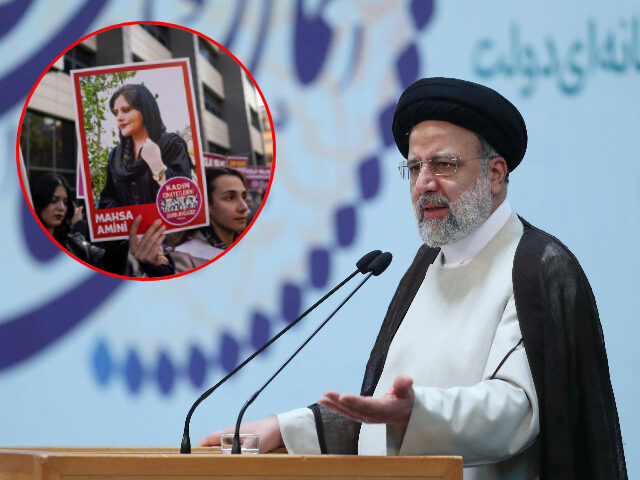Iranian President Ibrahim Raisi visited Iran’s Kurdistan province on Thursday – the home province of Mahsa Amini, a 22-year-old woman whom Iranian “morality police” beat to death for allegedly wearing a scarf improperly – dismissing months of nationwide protests and claiming the nation’s ethnic Kurds supported the Islamic regime.
Amini’s violent death occurred as a result of the Iranian Islamist regime forcing women to wear hijab, or Islamic headscarves, allegedly as a part of following the Islamic faith, though the Quran does not mention hijabs. Iranian Kurdistan has often been a source of opposition to the regime, as the Persian-led dictatorship has routinely used disproportionate brutality to repress ethnic minorities, particularly Kurds.
Kurds are the largest stateless ethnic group in the Middle East, their territory spanning Iran, Iraq, Syria, and Turkey. The governments of all four countries have for years violently opposed any attempt by Kurdish groups to establish sovereign nations and considered Kurdish organizations a national security threat, even as Kurdish militias proved instrumental in the destruction of the Islamic State’s Mideast “caliphate.”
Prior to becoming the Iranian president, Raisi was famously known as the mastermind behind the 1988 mass execution of between 5,000 and 30,000 people tied to the anti-regime leftist groups People’s Mojahedin Organization of Iran (PMOI) and the Mujahedin-e-Khalq (MEK). Raisi was in Kurdistan province reportedly to inaugurate a new drinking water project but spent his time there meeting with clerics and issuing statements condemning opponents of the regime and their alleged associates in the West.
“In the recent events, counterrevolution elements made a scandalous miscalculation as usual as part of their continued [acts of] betrayal, and other crimes were added to their past record of betrayals,” Raisi said in an address in the regional capital, Sanandaj, according to the Iranian state-run PressTV.
“They thought that they could achieve their malicious goals by creating chaos, insecurity and terrorist acts,” Raisi proclaimed, without specifically naming the alleged “counterrevolution elements” in question, “but they were dismissive of the fact that the noble people of Kurdistan have had … thousands of martyrs in the Revolution.”
Raisi also invoked the Iran-Iraq war of the 1980s to claim that Kurds overwhelmingly support the Islamist regime, despite the group’s prominence in the current protest movement.
Tasnim news, an Iranian regime-friendly outlet, quoted Raisi as lumping the ongoing, organic protests inside the country with “many conspiracies” created by foreign agents, presumably America and Israel, which the Iranian regime regularly threatens to destroy.
“The enemy designed and implemented many conspiracies against this nation to stop the Iranian nation. Among them were the eight-year imposed war and separatist provocations, including in Kurdistan, but the knowledgeable and insightful Kurdish people defeated the enemy,” Raisi claimed. “After the enemy did not get results from [the Iran-Iraq] war and separatist conspiracies, it imposed extensive sanctions against the Iranian nation to stop these people.”
Raisi claimed that the “enemy,” nonetheless, admitted “it has failed in applying these sanctions in the form of maximum pressure policy and therefore it has turned from pressure and sanctions to sedition and unrest.”
PressTV and Tasnim did not mention that Raisi was in Kurdistan for a water project. PressTV tied his visit directly to Mahsa Amini’s death in September and the protests that followed and continue unabated.
“In the past two months, and using the protests as a cover, rioters and thugs — many of whom were later found to have links with foreign parties — have been on a rampage,” PressTV claimed, “engaging in savage attacks on security officers, vandalism, desecration of sanctities, and false-flag killings of civilians to incriminate the Iranian police.”
The state outlet repeated its denial that regime agents beat Amini to death, instead claiming the 22-year-old, whose family has stated had no known medical problems at the time of her death, died of an unspecified “illness.”
The regime has also denied that repressive regime agents are behind the hundreds of deaths occurring during protests in Amini’s name. As of Monday, the Iranian government has admitted to over 300 “martyrs” in the protests but claimed the majority were police officers or other government officials killed by “rioters” or individuals killed as a result of protester behavior, not victims of police brutality. Human rights groups disagree. Iran Human Rights, an NGO based in Norway, has documented at least 448 people killed by police as of this week, according to France 24.
Iranian authorities continued to accuse foreign forces of fabricating a protest movement this week, rather than accepting that organic civil unrest exists in the country.
“Forty-seven spy agencies launched an all-out hybrid war against the Islamic Republic of Iran,” the head of the Basij, an internal security force used to crush unrest, said on Wednesday, claiming that the “hybrid war” was a result of foreign enemies being too afraid of a conventional war with Iran.
Brigadier General Gholamreza Soleimani, the Basij leader, claimed that the unnamed 47 spy agencies had planned for “riots” in October but expedited the timeline to capitalize on Amini’s killing. While 45 of the countries implicated remain anonymous, Soleimani claimed the alleged conspiracy was of “American-Israeli” origin.

COMMENTS
Please let us know if you're having issues with commenting.